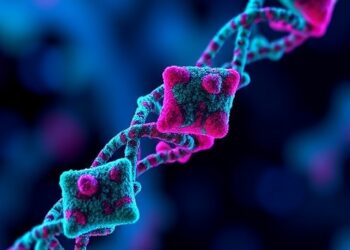A new vaccine against cancer-causing human papillomaviruses (HPV) is intended to help increase the rate of HPV vaccinations, particularly in developing countries. Scientists at the German Cancer Research Center (DKFZ) have developed a completely new vaccination concept for this purpose. The vaccine is inexpensive and protects mice against almost all cancer-causing HPV types. In addition to preventing new infections, the vaccine also triggers cellular immune responses against HPV-infected cells and may therefore also have a therapeutic effect against existing infections.
A new vaccine against cancer-causing human papillomaviruses (HPV) is intended to help increase the rate of HPV vaccinations, particularly in developing countries. Scientists at the German Cancer Research Center (DKFZ) have developed a completely new vaccination concept for this purpose. The vaccine is inexpensive and protects mice against almost all cancer-causing HPV types. In addition to preventing new infections, the vaccine also triggers cellular immune responses against HPV-infected cells and may therefore also have a therapeutic effect against existing infections.
Cervical cancer caused by certain types of human papillomavirus (HPV) is the fourth most common cancer in women worldwide. The majority of cases are diagnosed in less developed countries, particularly in South East Asia, Africa and Latin America. The carcinogenic so-called risk HPVs are mainly transmitted during sexual contact. The infections are very common. It is assumed that up to 80 percent of the population will come into contact with these viruses in their lifetime. In addition to cervical cancer, infections with high-risk HPV are also associated with oral cancer, anal cancer and other cancers of the genital organs.
The vaccines currently available against cancer-causing HPV are effective, but have limitations. They are temperature-sensitive and therefore require continuous refrigerated transportation, which poses a logistical problem in some countries. Their production is complex and expensive. In addition, they are only effective against certain cancer-causing HPV types. Above all, however, the established HPV vaccines show no therapeutic effects on existing infections.
In developing their new HPV vaccine, Müller and his colleagues took a systematic approach to solving all these problems. The basis for this was the “predecessor model” PANHPVAX, which was also developed in Müller’s laboratory: this exclusively prophylactic vaccine has already proven to be safe in phase I clinical trials and induces protective antibodies against all cancer-causing HPV as well as against some cutaneous papillomaviruses.
For PANHPVAX, the researchers used small fragments of the L2 protein from eight different HPV types. These fragments differ only slightly between different HPV types and can therefore trigger a very broad immune response. To make these protein snippets immunogenic, they were inserted into a suitable scaffold protein derived from a heat-loving microorganism (Pyrococcus furiosus).
“In our current work, we have added a therapeutic component to PANHPVAX, i.e. an antigen that stimulates the cellular immune response,” explains Müller. The DKFZ virologists chose the protein E7 of the two high-risk types HVP16 and 18. It is formed very early in the course of an HPV infection in the infected cells and is therefore an ideal target for a cellular immune response to eliminate these cells. However, E7 is also responsible for the malignant transformation of HPV-infected cells. The researchers therefore first had to modify the vaccine antigen so that it no longer posed a threat.
In preclinical studies, the new vaccine cPANHPVAX was able to trigger neutralizing antibodies against all carcinogenic HPV in mice and simultaneously activate cytotoxic T cells against the HPV16 protein E7.
These positive results encouraged the researchers to now produce cPANHPVAX under conditions that comply with Good Manufacturing Practice (GMP) guidelines for pharmaceuticals. The vaccine produced in this way can be used in clinical trials.
“Our major goal is to increase vaccination rates against HPV worldwide, especially in countries with limited resources. Our new, heat-stable vaccine is inexpensive to produce, protects against all cancer-causing HPV types and can potentially neutralize existing infections by combining it with E7.” In order to further investigate the promising properties of cPANHPVAX, the researchers are currently developing a concept for clinical testing of the vaccine.
The research on PANHPVAX and cPANHPVAX was funded by the Wilhelm Sander Foundation.
Xueer Zhao, Yeru Zhang, Oscar Trejo-Cerro, Ecem Kaplan, Zhe Li, Femke Albertsboer, Neyla El-Hammiri, Filipe Colaco Mariz, Lawrence Banks, Simone Ottonello, Martin Müller: A safe and potentiated multi-type HPV L2-E7 nanoparticle vaccine with combined prophylactic and therapeutic activity
NPJ Vaccines 2024, DOI 10.1038/s41541-024-00914-z
With more than 3,000 employees, the German Cancer Research Center (Deutsches Krebsforschungszentrum, DKFZ) is Germany’s largest biomedical research institute. DKFZ scientists identify cancer risk factors, investigate how cancer progresses and develop new cancer prevention strategies. They are also developing new methods to diagnose tumors more precisely and treat cancer patients more successfully. The DKFZ’s Cancer Information Service (KID) provides patients, interested citizens and experts with individual answers to questions relating to cancer.
To transfer promising approaches from cancer research to the clinic and thus improve the prognosis of cancer patients, the DKFZ cooperates with excellent research institutions and university hospitals throughout Germany:
National Center for Tumor Diseases (NCT, 6 sites)
German Cancer Consortium (DKTK, 8 sites)
Hopp Children’s Cancer Center (KiTZ) Heidelberg
Helmholtz Institute for Translational Oncology (HI-TRON Mainz) – A Helmholtz Institute of the DKFZ
DKFZ-Hector Cancer Institute at the University Medical Center Mannheim
National Cancer Prevention Center (jointly with German Cancer Aid)
The DKFZ is 90 percent financed by the Federal Ministry of Education and Research and 10 percent by the state of Baden-Württemberg. The DKFZ is a member of the Helmholtz Association of German Research Centers.
Contact:
Dr. Sibylle Kohlstädt
Strategic Communication and Public Relations
German Cancer Research Center
Im Neuenheimer Feld 280
D-69120 Heidelberg
T: +49 6221 42 2843
Email: presse@dkfz.de
Journal
npj Vaccines




